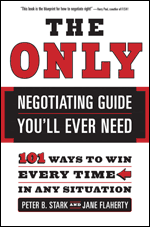Summary: Presenting a problem to a counterpart and challenging him to come up with creative options for a resolution.
This tactic is effective for encouraging your counterpart to come up with creative ways to achieve your goal. You present a challenge that your counterpart needs to help you overcome.
Example
An insurance company’s office supply manager tells a vendor, “I really enjoy working with you and I think your equipment and service are exactly what we need. The problem is, we have a budget of only $150,000 and you have quoted nearly $165,000. What can you do to help us stay within the budget?”
Counter
There are at least four possible counters to this tactic: (1) The vendor could explain how his products and services are designed to improve the insurance company’s long-term bottom line (e.g., by minimizing repairs or lengthening the time before a replacement is needed). (2) The vendor could use the Feel, Felt, and Found tactic, stating, “I understand you feel our price is a little high. Other customers have felt the same way at first but have found after a few years that our products and services are the best values on the market.” (3) Appealing to a Higher Authority might also be effective. The vendor could ask, “Could you check with your manager to see if the budget can be revised?” (4) Last, the vendor could try the If… Then tactic: “If we substituted a one-year warranty for our usual three-year warranty, then we could come a lot closer to your budgeted number. Would that be of interest to you?” The If… Then tactic usually leads to further negotiation and increases the probability of a win-win outcome for both counterparts.
Have you used or encountered this tactic in your negotiations? If so, how’d it go?




Speak Your Mind